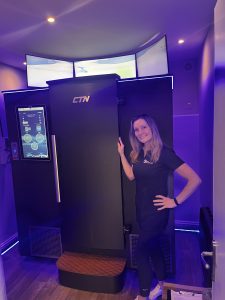Ever wondered why we have gone to the expense of being the 1st gym in the south west with its very own cryotherapy chamber? Well in short we think it’s brilliant for inflammation, recovery, training progress / gains, reducing pain, reducing stress and providing lots of happy chemicals. I know many of you would like to now the science of WHY? So here it is
1 -Cold Shock Response & Thermoregulation
When exposed to extremely cold temperatures (-140 C), the body activates its cold shock response, a survival mechanism designed to protect vital organs. The hypothalamus detects the rapid temperature drop and initiates vasoconstriction, which diverts blood from the extremities to the core. This preserves heat and oxygenates vital organs while reducing inflammation.
- Vasoconstriction: Blood vessels constrict to minimize heat loss.
- Vasodilation (Post-Treatment): After stepping out, blood vessels rapidly expand, increasing circulation and flushing out metabolic waste.
- Hormonal & Neurochemical Responses
Exposure to extreme cold triggers the release of key hormones and neurotransmitters:
- Endorphins & Norepinephrine: The cold exposure stimulates the release of norepinephrine (a neurotransmitter and hormone) and endorphins, leading to:
- Pain relief
- Improved mood & reduced anxiety
- Increased focus & alertness
- Cortisol Modulation: Some studies suggest cryotherapy may regulate cortisol (the stress hormone), potentially reducing chronic stress and inflammation.
- Anti-Inflammatory & Immune System Effects
- Reduction in Pro-Inflammatory Cytokines: Cryotherapy has been shown to reduce levels of TNF-α, IL-6, and IL-1β, key pro-inflammatory cytokines that contribute to chronic inflammation.
- Increase in Anti-Inflammatory Cytokines: At the same time, cryotherapy boosts IL-10, an anti-inflammatory cytokine that aids in tissue repair.
- Immune System Activation: Cold exposure may activate immune cells and enhance the body’s natural defense mechanisms.
- Metabolic & Mitochondrial Adaptations
- Brown Fat Activation & Thermogenesis: The cold stimulates brown adipose tissue (BAT), which generates heat by burning calories. This can enhance metabolism and energy expenditure.
- Mitochondrial Biogenesis: Repeated cold exposure may lead to increased mitochondrial efficiency, improving cellular energy production (ATP synthesis).
- Oxidative Stress & Antioxidant Production
- Cryotherapy Reduces Oxidative Stress: It can lower levels of reactive oxygen species (ROS), which contribute to cell aging and damage.
- Increased Antioxidant Enzymes: Cryotherapy boosts natural antioxidant production, including superoxide dismutase (SOD) and glutathione peroxidase, which protect cells from oxidative damage.
- Muscle Recovery & Performance Enhancement
- Reduced Muscle Damage: Cryotherapy decreases creatine kinase (CK) levels, a marker of muscle damage, helping with faster recovery.
- Lactic Acid Clearance: The rapid blood flow post-treatment helps remove lactic acid, reducing soreness.
- Neuromuscular Benefits: Cold exposure may enhance neuromuscular function, improving athletic performance.
Conclusion
The biochemical effects of Whole Body Cryotherapy are a combination of hormonal, inflammatory, and metabolic responses that help reduce pain, enhance recovery, and optimize performance. It works by triggering the body’s natural cold adaptation mechanisms, leading to benefits such as reduced inflammation, improved circulation, and neurochemical regulation.


